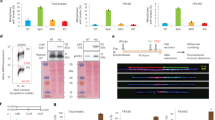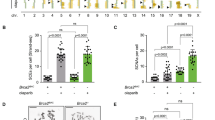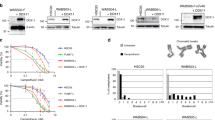Abstract
Several inherited syndromes in humans are associated with cancer predisposition. The gene products defective in two of these disorders, BLM (a helicase defective in Bloom's syndrome)1 and FANC A–N (defective in Fanconi anaemia)2, associate in a multienzyme complex called BRAFT3. How these proteins suppress tumorigenesis remains unclear, although both conditions are associated with chromosome instability. Here we show that the Fanconi anaemia proteins FANCD2 and FANCI specifically associate with common fragile site loci irrespective of whether the chromosome is broken. Unexpectedly, these loci are frequently interlinked through BLM-associated ultra-fine DNA bridges4 (UFBs) even as cells traverse mitosis. Similarly to fragile site expression5, fragile site bridging is induced after partial inhibition of DNA replication. We propose that, after replication stress, sister chromatids are interlinked by replication intermediates primarily at genetic loci with intrinsic replication difficulties, such as fragile sites. In Bloom's syndrome cells, inefficient resolution of DNA linkages at fragile sites gives rise to increased numbers of anaphase UFBs and micronuclei containing fragile site DNA. Our data have general implications concerning the contribution of fragile site loci to chromosomal instability and tumorigenesis.
This is a preview of subscription content, access via your institution
Access options
Subscribe to this journal
Receive 12 print issues and online access
$209.00 per year
only $17.42 per issue
Buy this article
- Purchase on Springer Link
- Instant access to full article PDF
Prices may be subject to local taxes which are calculated during checkout





Similar content being viewed by others
References
Ellis, N. A. et al. The Bloom's syndrome gene product is homologous to RecQ helicases. Cell 83, 655–666 (1995).
Wang, W. Emergence of a DNA-damage response network consisting of Fanconi anaemia and BRCA proteins. Nature Rev. Genet. 8, 735–748 (2007).
Meetei, A. R. et al. A multiprotein nuclear complex connects Fanconi anemia and Bloom syndrome. Mol. Cell. Biol. 23, 3417–3426 (2003).
Chan, K. L., North, P. S. & Hickson, I. D. BLM is required for faithful chromosome segregation and its localization defines a class of ultrafine anaphase bridges. EMBO J. 26, 3397–3409 (2007).
Durkin, S. G. & Glover, T. W. Chromosome fragile sites. Annu. Rev. Genet. 41, 169–192 (2007).
Mankouri, H. W. & Hickson, I. D. The RecQ helicase–topoisomerase III–Rmi1 complex: a DNA structure-specific 'dissolvasome'? Trends Biochem. Sci. 32, 538–546 (2007).
German, J. Bloom syndrome: a mendelian prototype of somatic mutational disease. Medicine (Baltimore) 72, 393–406 (1993).
Baumann, C., Korner, R., Hofmann, K. & Nigg, E. A. PICH, a centromere-associated SNF2 family ATPase, is regulated by Plk1 and required for the spindle checkpoint. Cell 128, 101–114 (2007).
Losada, A. & Hirano, T. Dynamic molecular linkers of the genome: the first decade of SMC proteins. Genes Dev. 19, 1269–1287 (2005).
Arlt, M. F., Casper, A. M. & Glover, T. W. Common fragile sites. Cytogenet. Genome Res. 100, 92–100 (2003).
Casper, A. M, Nghiem, P, Arlt M.F & Glover T. W. ATR regulates fragile site stability. Cell 13, 779–789 (2002).
Schwartz, M. et al. Homologous recombination and nonhomologous end-joining repair pathways regulate fragile site stability. Genes Dev. 19, 2715–2726 (2005).
Durkin, S. G. et al. Replication stress induces tumor-like microdeletions in FHIT/FRA3B. Proc. Natl Acad. Sci. USA. 8, 246–251 (2007).
Wang, L. H., Schwarzbraun, T., Speicher, M. R. & Nigg, E. A. Persistence of DNA threads in human anaphase cells suggests late completion of sister chromatid decatenation. Chromosoma 117, 123–135 (2008).
Taniguchi, T. et al. Convergence of the Fanconi anemia and ataxia telangiectasia signaling pathways. Cell 109, 459–472 (2002).
Hirota, T., Gerlich, D., Koch, B., Ellenberg, J. & Peters, J. M. Distinct functions of condensin I and II in mitotic chromosome assembly. J. Cell Sci. 15, 6435–6445 (2004).
Acknowledgements
We thank members of the Hickson laboratory for helpful discussions, P. McHugh and L. Wu for helpful comments on the manuscript, and P. White for preparation of the manuscript. B. Lopes, P. Jeggo, F. Esashi, A. D'Andrea, G. Brown, E. Nigg and S. Elledge kindly supplied reagents. This work was supported by Cancer Research UK. K.L.C. was supported by the Croucher Foundation (Hong Kong).
Author information
Authors and Affiliations
Contributions
K.L.C., T.P.P. and S.Y. performed experiments and, together with I.D.H., analysed data. K.L.C. and I.D.H. planned experiments and wrote the manuscript.
Corresponding author
Ethics declarations
Competing interests
The authors declare no competing financial interests.
Supplementary information
Supplementary Information
Supplementary Information (PDF 1608 kb)
Rights and permissions
About this article
Cite this article
Chan, K., Palmai-Pallag, T., Ying, S. et al. Replication stress induces sister-chromatid bridging at fragile site loci in mitosis. Nat Cell Biol 11, 753–760 (2009). https://doi.org/10.1038/ncb1882
Received:
Accepted:
Published:
Issue Date:
DOI: https://doi.org/10.1038/ncb1882
This article is cited by
-
Chronic replication stress invokes mitochondria dysfunction via impaired parkin activity
Scientific Reports (2024)
-
Mitotic DNA synthesis in response to replication stress requires the sequential action of DNA polymerases zeta and delta in human cells
Nature Communications (2023)
-
Mitochondrial complex III deficiency drives c-MYC overexpression and illicit cell cycle entry leading to senescence and segmental progeria
Nature Communications (2023)
-
An ATR-PrimPol pathway confers tolerance to oncogenic KRAS-induced and heterochromatin-associated replication stress
Nature Communications (2023)
-
TRAIP resolves DNA replication-transcription conflicts during the S-phase of unperturbed cells
Nature Communications (2023)



